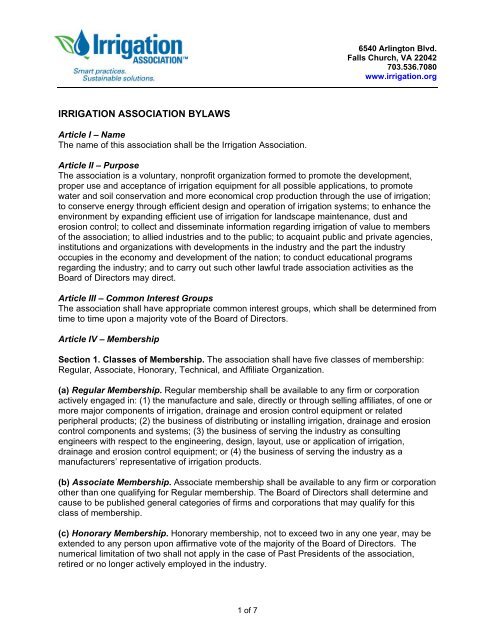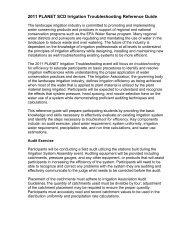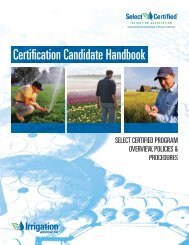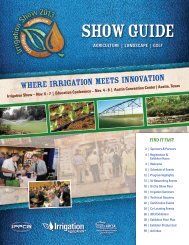IRRIGATION ASSOCIATION BYLAWS
IRRIGATION ASSOCIATION BYLAWS
IRRIGATION ASSOCIATION BYLAWS
- No tags were found...
You also want an ePaper? Increase the reach of your titles
YUMPU automatically turns print PDFs into web optimized ePapers that Google loves.
6540 Arlington Blvd.<br />
Falls Church, VA 22042<br />
703.536.7080<br />
www.irrigation.org<br />
<strong>IRRIGATION</strong> <strong>ASSOCIATION</strong> <strong>BYLAWS</strong><br />
Article I – Name<br />
The name of this association shall be the Irrigation Association.<br />
Article II – Purpose<br />
The association is a voluntary, nonprofit organization formed to promote the development,<br />
proper use and acceptance of irrigation equipment for all possible applications, to promote<br />
water and soil conservation and more economical crop production through the use of irrigation;<br />
to conserve energy through efficient design and operation of irrigation systems; to enhance the<br />
environment by expanding efficient use of irrigation for landscape maintenance, dust and<br />
erosion control; to collect and disseminate information regarding irrigation of value to members<br />
of the association; to allied industries and to the public; to acquaint public and private agencies,<br />
institutions and organizations with developments in the industry and the part the industry<br />
occupies in the economy and development of the nation; to conduct educational programs<br />
regarding the industry; and to carry out such other lawful trade association activities as the<br />
Board of Directors may direct.<br />
Article III – Common Interest Groups<br />
The association shall have appropriate common interest groups, which shall be determined from<br />
time to time upon a majority vote of the Board of Directors.<br />
Article IV – Membership<br />
Section 1. Classes of Membership. The association shall have five classes of membership:<br />
Regular, Associate, Honorary, Technical, and Affiliate Organization.<br />
(a) Regular Membership. Regular membership shall be available to any firm or corporation<br />
actively engaged in: (1) the manufacture and sale, directly or through selling affiliates, of one or<br />
more major components of irrigation, drainage and erosion control equipment or related<br />
peripheral products; (2) the business of distributing or installing irrigation, drainage and erosion<br />
control components and systems; (3) the business of serving the industry as consulting<br />
engineers with respect to the engineering, design, layout, use or application of irrigation,<br />
drainage and erosion control equipment; or (4) the business of serving the industry as a<br />
manufacturers’ representative of irrigation products.<br />
(b) Associate Membership. Associate membership shall be available to any firm or corporation<br />
other than one qualifying for Regular membership. The Board of Directors shall determine and<br />
cause to be published general categories of firms and corporations that may qualify for this<br />
class of membership.<br />
(c) Honorary Membership. Honorary membership, not to exceed two in any one year, may be<br />
extended to any person upon affirmative vote of the majority of the Board of Directors. The<br />
numerical limitation of two shall not apply in the case of Past Presidents of the association,<br />
retired or no longer actively employed in the industry.<br />
1 of 7
(d) Technical Membership. Technical membership shall be available to university and<br />
government personnel engaged in the study of research on irrigation interested in engineer,<br />
design, layout, use or application or irrigation equipment.<br />
(e) Affiliate Organization Membership. Affiliate Organization membership shall be available to<br />
any association or society functioning on a state or regional basis to promote the interests of the<br />
irrigation industry on a local level.<br />
Exceptions to any of the foregoing requirements for any category of membership may be made<br />
by majority vote of the Board of Directors upon its determination that the particular<br />
circumstances will not be to the detriment of the association or the applicant.<br />
Section 2. Application for Membership. Application for membership shall be made on a form<br />
approved by the Board of Directors. The application shall be completed in full and sent to the<br />
Executive Office of the association. If there is a question with respect to the eligibility of an<br />
applicant, the Executive Director shall submit the application to the Board of Directors for<br />
review. If the applicant is eligible for membership under these bylaws, the applicant shall be so<br />
notified and shall become a member upon receipt of dues as established by the Board of<br />
Directors.<br />
Section 3. Meetings. An annual meeting of the members of the association shall be held at<br />
such place and at such time as the Board of Directors shall determine. Per Delaware law, notice<br />
of the time and place of the annual meeting, shall be distributed to each member of the<br />
association 10 to 60 days prior to the date of such meeting.<br />
Special meetings of the members of the association may be called by the President or by order<br />
of the Board of Directors at any time, either at the principal office of the association, or<br />
elsewhere, and notice of such meeting shall be distributed by the Executive Director to each<br />
member at least 30 days before such meeting. It shall be the duty of the President to call a<br />
special meeting of the members upon written request by 25 percent of the Regular and Affiliate<br />
Organization members of the association.<br />
Attendance at any annual or special meeting is limited to members, applicants for membership<br />
and guests invited on authorization of the Board of Directors.<br />
Section 4. Voting Rights, Quorum, Balloting. Each Regular and Affiliate Organization<br />
member of the association shall be entitled to one vote in official association matters. Other<br />
classes of membership shall not have voting privileges and individuals representing these<br />
classes may not be officers or directors.<br />
(a) Voting at Meetings. A Regular or Affiliate Organization member may be represented and<br />
vote at any meeting of the association or by proxy, provided written notice of the proxy is<br />
delivered to the Executive Director before the opening of the meeting at which the proxy is to be<br />
exercised.<br />
One-fourth of the Regular and Affiliate Organization members of the association shall constitute<br />
a quorum for the conduct of business. Except as otherwise required by the bylaws, any matter<br />
presented at a meeting for the vote of the Regular and Affiliate Organization members shall be<br />
determined in accordance with the majority vote of those present and voting in person or by<br />
proxy.<br />
(b) Voting by Ballot. Whenever, in the judgment of the Executive Committee, a question arises<br />
that requires a vote of the membership and the calling of a meeting does not appear to be<br />
necessary, the membership may be polled by mail, fax or electronically. In conducting a ballot,<br />
2 of 7
the Executive Director shall send ballots to all Regular and Affiliate Organization members of<br />
the association. On all mail, fax or electronic ballots, the voting of the majority of the members<br />
voting shall prevail.<br />
Section 5. Voluntary Termination. A membership may be terminated voluntarily on written<br />
notice from the member to the Executive Director.<br />
Section 6. Involuntary Termination. The Executive Director must terminate a membership for<br />
delinquency in the payment of dues. The Board of Directors, by the affirmative vote of twothirds<br />
of the members of the Board, may, after proper investigation, due notice and the<br />
opportunity for a hearing, suspend or terminate any member:<br />
(a) For ceasing to qualify for membership;<br />
(b) If the member’s conduct becomes detrimental, in the opinion of the Board, to the welfare<br />
and interests of the Association; or<br />
(c) For unauthorized activities or statements in the name of or on behalf of the Association or<br />
any officer or committee thereof.<br />
Section 7. Effect of Termination; Reinstatement. When a membership is terminated for any<br />
reason, the member gives up all claims to an interest in the association’s assets. Any member<br />
suspended or terminated for nonpayment of dues may be reinstated by the Executive Director<br />
when payment has been made. Any member suspended or terminated for unauthorized<br />
activities or detrimental conduct, may be reinstated by a majority vote of the Board of Directors<br />
provided it qualifies for membership.<br />
Article V – Officers<br />
Section 1. Officers. The officers of the association shall be a President, President-Elect, Vice<br />
President, and Treasurer.<br />
Section 2. Election and Term. The Board of Directors shall elect the Vice President and<br />
Treasurer annually. Each officer shall serve for one year, or until a successor has been elected<br />
and qualified or the officer has resigned or been removed. The President-Elect automatically<br />
becomes President following his term as President-Elect, and the Vice President automatically<br />
becomes President-Elect. The term of each officer ends upon the installation of newly elected<br />
officers.<br />
Section 3. Duties. The President, or the President-Elect in the President’s absence, shall<br />
preside at all annual meetings of the membership, the Board of Directors and the Executive<br />
Committee. Otherwise, the elected officers shall perform the duties incident to their respective<br />
offices and any other duties assigned them by these bylaws. The Treasurer shall be bonded in<br />
an amount determined by the Board of Directors, and the premium for such bond shall be paid<br />
for by the association.<br />
Section 4. Vacancies. Should the Presidency become vacant before the normal expiration of a<br />
term, the President-Elect shall succeed to the Presidency. Should the office of the President-<br />
Elect become vacant before the normal expiration of a term, the Vice President shall succeed to<br />
that office. The term of service in such cases shall be for the unexpired term of the person<br />
succeeded and, therefore, for the usual term of the person’s office. Should the office of Vice<br />
President or Treasurer become vacant before the normal expiration of a term, a successor shall<br />
be elected by the Board of Directors to serve for the unexpired term of the person succeeded.<br />
3 of 7
Article VI – Board of Directors<br />
Section 1. Membership. The Board of Directors shall be composed of the four officers of the<br />
association, representatives of 10 Regular or Affiliate Organization members and the immediate<br />
Past President. Directors, other than officers, shall serve for three years.<br />
Section 2. Nomination. The President, with the approval of the Board of Directors, shall<br />
appoint a Directors Nominating Committee to recommend a slate of candidates to fulfill the<br />
expired terms of directors. The Directors Nominating Committee may not exceed six members<br />
and shall be representative of the voting membership.<br />
The Directors Nominating Committee shall present to the membership its recommended slate of<br />
candidates for vacancies on the Board of Directors not later than 30 days prior to the annual<br />
membership meeting. A ballot shall provide Regular and Affiliate Organization members an<br />
opportunity to nominate additional candidates through a write-in procedure.<br />
Section 3. Election and Term. Directors shall be elected by a majority vote of the Regular and<br />
Affiliate Organization members. If a candidate does not receive a majority on the first ballot<br />
taken, the two highest candidates shall be voted for on the next ballot. Each director shall serve<br />
for a term of three years, or until a successor has been elected and qualified, or the director has<br />
resigned or been removed. The term of each director ends upon the installation of newly elected<br />
directors.<br />
Section 4. Powers and Duties. The Board of Directors is the governing body of the association<br />
subject to control by the Regular members. The Board shall carry out the duties assigned by<br />
these bylaws and take such other action as it deems necessary to accomplish the purposes of<br />
the association. It may adopt rules to accomplish these purposes provided they do not conflict<br />
with these bylaws or the association’s articles of incorporation.<br />
Section 5. Audit and Financial Statement. The Board of Directors shall annually cause the<br />
books and accounts of the association to be audited by an independent certified public<br />
accountant and shall submit an audited financial statement to the members not later than 150<br />
days after the close of the fiscal year.<br />
Section 6. Meetings. The Board of Directors shall hold three regular meetings annually. The<br />
Board may hold such other regular and special meetings as it may deem necessary or as may<br />
be provided in the bylaws.<br />
Section 7. Voting, Quorum and Balloting. The requirement as to voting and ballots set forth<br />
for the membership in Article IV, Section 4 of these bylaws shall govern the voting of the Board.<br />
A majority of the members of the Board shall constitute a quorum.<br />
Section 8. Vacancy and Removal. If a Director resigns or is unable to serve his term, the<br />
vacancy shall be appointed by the President with the approval of the Board of Directors. Any<br />
Director so appointed shall continue in office for the unexpired term of the person succeeded or<br />
until the Director’s successor is elected and qualified. A Director may be removed by a twothirds<br />
vote of the Board for not abiding by the IA Board of Directors’ Policy Manual.<br />
Section 9. Past President. Each Past President of the association, other than the Immediate<br />
Past President, shall be an ex-officio member of the Board of Directors. As an ex-officio<br />
member, he shall be entitled, if he so desires, to attend all meetings of the Board of Directors.<br />
He shall have privileges of the floor in discussion of any subject being considered by the Board,<br />
but he may not offer or second motions, or vote on pending questions. Notices of meetings of<br />
4 of 7
the Board of Directors, copies of budget and financial reports and minutes of all Board<br />
proceedings may be requested by a Past President.<br />
Article VII – Executive Committee<br />
The Executive Committee shall be composed of the association President, President-Elect, Vice<br />
President, Treasurer, and Immediate Past President. The Executive Committee shall meet at<br />
the call of the President, and may act for the Board of Directors subject to the Board’s review.<br />
Three members of the Committee shall constitute a quorum. Questions presented to the<br />
Committee shall be determined in accordance with a majority vote.<br />
Article VIII – Executive Director<br />
The association shall have an Executive Director, to be selected by the Board of Directors, to<br />
serve on such terms as may be determined by the Board. The Executive Director shall serve the<br />
function of Secretary of the association, the Board and the Executive Committee, but shall not<br />
be an officer of the association. The Executive Director shall have such further duties as are<br />
assigned by the Board or by these bylaws.<br />
Article IX – Fiscal Year, Dues and Assessments<br />
Section 1. Fiscal Year. The association’s fiscal year shall be from July 1 through June 30.<br />
Section 2. Dues. Dues for all classes of membership shall be determined by the Board of<br />
Directors.<br />
Section 3. Assessments. There shall be no assessments levied by the association.<br />
Article X – Committees<br />
Section 1. Executive Committee. The association shall have an Executive Committee in<br />
accordance with the provisions of Article VII.<br />
Section 2. Directors Nominating Committee. The association shall have a Directors<br />
Nominating Committee in accordance with the provisions of Article VI, Section 2.<br />
Section 3. Finance Committee. A Finance Committee shall consist of the (1) President, (2)<br />
Executive Director, (3) Treasurer.<br />
The Executive Director and staff shall provide the Finance Committee with an annual budget<br />
proposal at least 30 days prior to the annual membership meeting. The Finance Committee<br />
shall then prepare an annual budget. The budget, as approved by the Executive Committee,<br />
shall be presented to the Board of Directors for the Board’s approval at its meeting immediately<br />
following the annual membership meeting.<br />
The budget, upon its adoption, shall control the expenditures of the association’s funds. Any<br />
expenditure in excess of amounts budgeted, or any contemplated expenditure not budgeted,<br />
must have the approval of the Executive Committee before the expenditure is made. The<br />
Executive Committee, with the approval of the Board of Directors, shall make investments of<br />
any surplus funds of the association and shall dispose of such investments when considered<br />
advisable by the Board of Directors.<br />
Section 4. Certification Board. The Irrigation Association Certification Board is an independent<br />
board that shall govern the IA certification program. The Certification Board shall have<br />
autonomy in making decisions regarding important aspects of the certification program including<br />
eligibility standards; the development, administration and scoring of the assessments;<br />
5 of 7
certification disciplinary issues; selection of Certification Board members, and operational<br />
processes such as application review, registration processing, and candidate communication.<br />
Section 5. Other Committees. The Board of Directors shall establish such other committees as<br />
it deems necessary to protect and further the interests of the association. Members of such<br />
committees shall be appointed by the President, subject to the approval of the Board.<br />
Article XI – Chapters<br />
Section 1. The association shall encourage and recognize the establishment of geographicallybased<br />
chapters of its members to further its goals.<br />
Section 2. Chapters may be certified under such rules and policies as may be adopted by the<br />
Board of Directors from time to time.<br />
Article XII – Rules of Order<br />
All meetings and other actions of the association, its Board of Directors, committees and<br />
common interest groups shall be governed by these bylaws. In matters of parliamentary<br />
procedure, decisions shall be made in accordance with Robert’s Rules of Order latest edition,<br />
except in the case of a conflict with these bylaws, in which event the bylaws shall control.<br />
Article XIII – Indemnity<br />
Any person made a party to any legal action by reason of the fact that he, his testator, or<br />
intestate is or was a director, officer or employee of the association or any corporation which he<br />
served at the association’s request, shall be compensated by the association for reasonable<br />
expenses, including attorney’s fees necessarily incurred by him in connection with the action or<br />
with any appeal therein, together with any amounts paid by said person in discharge of<br />
judgments, awards and damages arising out of such legal action. This right to indemnification<br />
does not apply if, in the action taken, the officer, director or employee is adjudged liable for<br />
negligence or misconduct in the performance of his duty. The right of indemnification<br />
established in this article does not exclude any other rights to which such director, officer or<br />
employee may be entitled.<br />
Article XIV – Amendments<br />
These bylaws may be amended by the majority vote of the Regular and Affiliate Organization<br />
membership, at any duly constituted meeting of such membership, provided that written notice<br />
of the proposed amendment is sent with the notice for such meeting at least 30 days prior to the<br />
date of the meeting; or by mail, fax or electronic ballot, provided that 30 days are allowed for the<br />
voting period. Such notice is not necessary when amendments are proposed at the annual<br />
meeting and unanimously approved by those Regular and Affiliate Organization members<br />
present.<br />
Article XV – Leadership Positions<br />
All persons elected or appointed to positions of leadership in the association must either be<br />
members or be employed by firms which are members of the association. “Positions of<br />
leadership” are defined as: officers, directors, committee/common interest group chairs and vice<br />
chairs, members of the IA Certification Board, and other such positions as may be established<br />
by the Board of Directors.<br />
Article XVI – Dissolution<br />
The association may be dissolved with the consent of two-thirds of the Regular members given<br />
in writing at a meeting duly constituted to consider the question of dissolution. Any funds<br />
remaining in the treasury after all financial obligations of the association have been met shall be<br />
returned to the Regular members in the proportion contributed by any member during the last<br />
6 of 7
year of the existence of the association. The balance, if any, shall be distributed to such<br />
charitable organizations as may be selected by the Board of Directors. •<br />
Effective May 2011<br />
7 of 7







